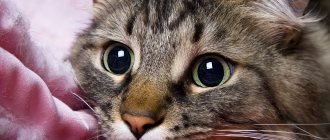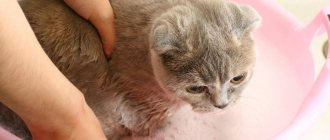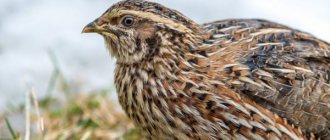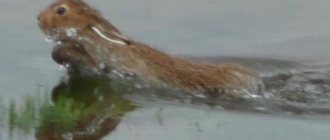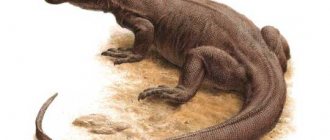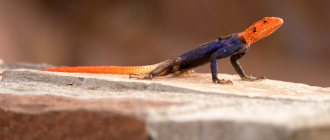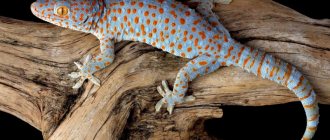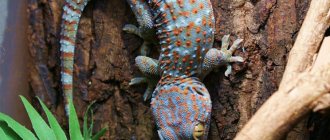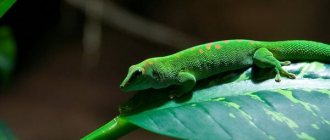Lekka geckos are large lizards and are far from songbirds, but their vocal abilities are very funny. Many reptile lovers keep toki geckos at home due to their interesting ability to make different sounds.
In different languages, these large lizards are called tuko, tokei, tokek and toko. They owe these names precisely because of the sounds they make. First, the gecko clucks, and then loudly shouts “to-kay, puh-kay, kee-kay.” The sounds of current geckos during the mating season are very diverse; they can resemble trills and sometimes barks. Smith's geckos make similar sounds.
Distribution and habitats of current geckos
Tree geckos are nocturnal. They are native to Southeast Asia, with a range that includes Bangladesh, India, the Philippines, New Guinea and Indonesia.
The habitat of lekki geckos is trees of the tropical forest, they are also found in rocks and villages in rural areas, they can often be seen running along the walls of people's buildings, where they look for insects.
In the 80-90s, these geckos were brought to Florida, Hawaii, Belize, Texas and some Caribbean islands.
Toki gecko (Gekko gecko).
Flying individuals
There is such a unique species from the family of lizards - Kühl's lobe-tailed gecko or flying one. The peculiarity of the species is that the animal practically floats from one tree to another. The reptile lives only in trees and is found on the islands of Indonesia and the Malay Peninsula. The animal's paws are webbed, and its tail is very long, up to 20 centimeters, which allows it to easily jump from tree to tree.
When keeping flying geckos, you will need a fairly high and wide terrarium, at least 90 centimeters high. There should be a lot of things inside that will bring the reptile’s existence as close as possible to natural conditions, that is, it should be able to jump. They live relatively short, about 8 years.
Description of current geckos
These geckos are the second largest in body size among the lizards of the clasp-toed family. The body length of males reaches 30-40 centimeters, and the size of females is 20-30 centimeters. The weight of these geckos ranges from 150 to 300 grams.
The body color of toki geckos is grayish or bluish. Against the general background there may be spots of any shade - from bright yellow to light yellow.
Male toki geckos are brighter in color. The skin of toki geckos is velvety and soft to the touch. Depending on the environment, body color may darken or lighten. The body shape is cylindrical, slightly flattened at the sides. The head is relatively large.
The eyes are large and protruding and may be orange, green-brown or yellow. The pupil of the eyes is vertical. The third eye is located on the top of the head; it is poorly developed, in its infancy, and it is believed that it perceives differences in lighting. On both sides of the head there are ears that look like holes. Toki geckos have small bristles on their toes, allowing them to run quickly even on slippery surfaces. The mouth contains many small but extremely sharp teeth.
The gecko's eyelids are fused, like those of snakes, and transparent.
What to feed
Young reptiles need to be given food 5-6 times a week. With an increase in the body and thickness of the tail, the frequency of the procedure decreases to 2-3. Geckos require food that is rich in protein:
- insect larvae;
- worms;
- cicadas;
- cockroaches;
- crickets.
Large species can eat small mice, frogs, scorpions and young snakes, quail eggs. The use of additives is not prohibited, especially those that contain a large proportion of calcium. It is best to feed them to future prey, and after 24 hours you can treat your pet with healthy food. Species that are active during the day like oranges and bananas; they can be pampered with honey once a week.
Geckos require dechlorinated warm water. Distillation and tap water are detrimental to the health of these reptiles.
Types of lekki geckos
Among the lek geckos, there are 2 subspecies: • G. gecko azhari live only in Bangladesh; • G. gecko gecko live in tropical Asia and are distributed from India to Indonesia. Lifestyle of lekki geckos
Males do not tolerate the presence of other geckos on their territory; they furiously attack trespassers. Males meet with partners only during the breeding season.
The female lays 1-2 hard and sticky eggs. Masonry is done in rocks, on the eaves of houses and in other shelters. The female guards the eggs until the young are born. The sticky shell of eggs prevents them from rolling, even if they are on an inclined plane.
In the area where they are found, males make their presence known by loud sounds.
In captivity, females often eat their eggs, so it is recommended to remove them from the terrarium. Current geckos feed on small vertebrates and insects.
Contents in a terrarium
Before you get a Gecko at home, you need to buy a terrarium or make one yourself. Horizontal or vertical - depends on the type of individual: the first is suitable for reptiles whose natural habitat is deserts and steppes (stones and some plants should be laid out along the bottom), and the second will appeal to those who like to climb trees (large branches and shelves will be needed inside) .
A lid, as well as a container of water, are required.
The following is suitable as bedding for covering the bottom with a slight degree of humidity:
- cypress mulch;
- coconut flakes;
- gravel (large pieces).
The layer of filler should be 8-10 cm. The lizard often eats it along with food, this causes blockage of the digestive tract, respiratory tract and leads to the death of the pet. This must be taken into account when choosing soil; the size of its fractions should exclude this possibility.
During the daytime, you need to maintain the temperature at +30...+35 °C, reducing the value by 6-8 °C at night. To create an optimal microclimate inside the terrarium, houseplants will do. Only day geckos need regular exposure to ultraviolet light.
It is recommended to maintain air humidity within 65-80%. For this purpose, you can spray with warm water 1-2 times a day. It should be remembered that if the air in the terrarium is too dry, the pet will not be able to safely change its skin and will die. After all, geckos molt regularly, especially during the growth period (up to twice a month).
Slots covered with mesh will provide ventilation. It is also urgently needed; it helps prevent the processes of rotting and the formation of pathogenic bacteria in the tank.
Regular washing of the terrarium will be required in a specially designated room without the use of chemicals, since when contaminated, individuals can be carriers of life-threatening diseases.
Curious lizard
If you have a warehouse of firewood or old boards on your site, then it is very likely that one day you will find a curious lizard studying the world around you from some crevice, or simply basking in the sun. Sometimes their presence nearby is unnoticed, and the small muzzle of a lizard can come as a surprise to an inattentive summer resident, but with a certain patience and a little bit of luck, the lizards get used to the neighborhood, and you can feed them by luring them out of their hiding places and admiring the fun games of the little “dinosaurs.”
Curious lizard
It is most likely that your dacha neighbor will be the Common Lizard, also called Prytka or Agile. These are small reptiles, usually ranging in size from 10 to 15-17 centimeters. According to textbooks, they can reach 35 cm, but I have never seen such large ones. The color of lizards is gray-brown, with stripes and spots. Each individual has a unique skin pattern, and by looking at a family of lizards consisting of several individuals, you can learn to distinguish them. The coloring camouflages lizards well against the background of old wood, earth, or clay, but sometimes gives them away if they climb a light tree or find themselves on a light sandy path. During the mating season, males turn greenish and cannot be found in the grass. This effect is probably needed for additional camouflage protection, or perhaps, from the point of view of female lizards, “the greener the more beautiful.”
Grinded dinosaur
The most famous feature of lizards is the ability to drop their tail if attacked by a predator. The tail then grows back, but careful observers will notice that new tails are often shorter and covered with a coarser coat. This is hardly such a harmless test for the lizard as is commonly thought. Sometimes lizards shed their tails when you try to pick them up, so no matter how much you want to catch a lizard and cuddle a little, you should not cause pain and stress to the tiny creature, which naturally regards this as an attack.
Lizard on an old beam
Lizards make quite specific whistling sounds, but you need to find out that this is the “language” of the lizard, otherwise they can be mistaken for the whistle of a small bird or some kind of undetectable background sound, of which there are many in nature, and which Homo sapiens have long forgotten how to define and identify.
Lizards, like many reptiles, have a special sensory organ that detects thermal changes in the surrounding space. This heat-sensitive area is located on the nose. Lizards are often spotted standing motionless in direct sunlight. Some biologists suggest that lizards do not so much warm themselves (unlike mammals), they are cold-blooded creatures, but rather receive some kind of information or simply experience pleasure, perhaps similar to the pleasure of tasty food.
Lizard in profile
Lizards feed on almost any insects, both adults and in the stage of larvae and caterpillars, as well as spiders and arachnids, mollusks, and worms. And therefore, for a summer resident, lizards are friends and helpers who save plants from being eaten and damaged. Lizards do not build nests, nor do they dig burrows. They find shelter in some natural, usually woody, crevices and burrows - peelings of bark, piles of branches, in the cracks of fallen trees.
Is it getting warm? Gathering information? Resting?
Lizards are bisexual creatures, with a clear division into males and females. Lizards lay eggs, which hatch into tiny babies. Some species of lizards care for both eggs and hatchlings. Others are capable of devouring their own offspring. It is impossible to say for sure how nimble lizards are caring parents. Most likely, their parental involvement depends on external circumstances. If there is enough food, they will take care of the cubs, and in drought and famine they will survive at any cost.
Common lizard
Under natural conditions, lizards are hunted by large birds and small predators. In dacha conditions, the main enemies of lizards are cats. Usually they do not eat lizards, but they are happy to torture them in their favorite game of “release and catch”, and even throwing away the tail does not save the lizards from their cruel claws.
Some weak-minded summer residents imagine lizards as pests and also feel hostility towards these cute creatures. It’s a pity, but they are exterminated using poisons and spraying their most common habitats - boards, old cut trees, stumps. There is no point in this fanaticism, as well as in fueling some pseudo-instinctive desire to deal with any living creature just because its appearance seems unsightly. If only these lovers of beauty could see their faces through the eyes of lizards. We still have to look for such demons.
Agile lizard
The common or sand lizard is ubiquitous in the European part of Russia, where it is a fairly stable species, but it should be borne in mind that throughout almost the entire territory of Europe the common lizard is recognized as an endangered species, the number of which is declining due to unknown factors. A vague and vague “disturbance in the balance of the ecosystem” can conceal anything. I wouldn’t want to step on such a rake and lose the beautiful and positive dinosaurs of our dacha worlds.
Fast lizard
Text, photo - Lazy Summer Resident, 2013, 2015
Source
When do lizards communicate?
Like humans and many other animals, lizards must be able to communicate in a variety of scenarios. Lizards must be able to communicate with members of their own species. This type of communication, called intraspecific, includes communication related to finding suitable mates (called courtship) and competition for resources such as food or habitat. Lizards can take subtle differences in traits found among members of the same species into account when choosing mates, sometimes causing some individuals to mate more often than others. This phenomenon is related to sexual selection and is not discussed here (see Sexual selection in lizards).
In many cases, lizards also communicate with members of different species, which is called interspecific communication. Some lizards compete with other lizard species for access to resources, and they need ways to communicate with each other in the process. Some lizards use interspecific communication during predator-prey interactions. Lizard Anolis cristatellus
, for example, demonstrates the ability to deter predators—
A. cristatellus
behaves in a way that conveys information about the lizard's physiological state to potential predators. Lizards that are in better condition (and may be more likely to elude a predator) exhibit this behavior more often and can communicate to the predator that they will be difficult to catch. Thus, a predator may prefer to avoid lizards in good condition that may outrun them, and instead pursue individuals that do not appear to be in good condition. In this case of interspecific communication, the lizard transmits information about itself to the predator, and the predator changes its behavior in response.
Lizard communication methods
Lizards have many different communication needs and have developed several communication methods to meet these needs. These modes include visual, chemical, tactile, and vocal communication. Chemical and visual modes of communication are widespread among lizards, while tactile and vibration modes appear to be found only in a few species of lizards. Some species use a combination of several modes of communication, while others seem to rely entirely on one. Visual communication is the most well-studied way lizards communicate, but modern scientific techniques are making it easier to study other methods. Thus, we may find that lizards that traditionally rely on one mode of communication may also use another method.
Visual communication
Many lizards use visual communication. Lizards that use visual communication gather information by observing various physical and behavioral characteristics of other lizards, much like humans communicate using body language. Lizards that use visual communication often have highly developed visual systems—most can see different colors, and some can even see ultraviolet light. Lizards use many different physical and behavioral traits in visual communication, most of which are apparently designed to attract the visual attention of other lizards.
What character traits attract visual attention? Lizards that use visual communication often have specialized structures used for communication. These structures often include bright colors and striking patterns, accompanied by whimsical behaviors designed to display these traits, all intended to attract attention during communication. In many cases, these structures are hidden from view except when they are used for communication—colors that attract the attention of other lizards may also attract the attention of unwanted audiences such as predators or competitors. Thus, these colors may be located on a flap of skin that is only visible when the lizard pulls it out, or on a body surface such as the belly that is not exposed unless the lizard intends to. Both are common in lizards. Many species of Anolis
lizards have folded, vibrantly colored throat fans that they extend during behavioral interactions like attracting mates and duels with competitors.
Anole
lizards tend to be quite well camouflaged, except for the bright color of their dewlap, and often go undetected until they extend their dewlap.
Many species skeloporous
lizards also have hidden coloration.
Many Sceloporous
develop
a striking blue-black belly during the breeding season This color is not visible to other lizards unless the lizard exhibits a behavior called dorsal flattening, where the lizard flattens its body to expose colorful parts of its abdomen during behavioral interactions.
Because lizards that use visual communication rely on the ability to see other lizards, visual communication is common among species that live in relatively high population densities and frequently come into close contact. Visual communication is well suited for use in many different habitats and can be modified by lizards to adapt to changing habitat conditions [for example] if humans come into contact frequently enough.
Chemical communication
Another method of communication used by many lizards is chemical communication. Lizards that use chemical communication produce chemicals that they deposit in the environment, such as pheromones. These chemicals cause changes in the behavior and sometimes physiology of the people they encounter. These chemicals contain unique combinations of "ingredients" of the chemical compound, and different combinations of ingredients can provide information about the person who produced the chemical. In many cases, the chemical composition varies significantly between species, allowing lizards to tell whether the lizard that deposited the chemical was a member of the same or a different species. More interestingly, some species of lizards (such as the Iberian rock lizard, Lacerta monticola
) their chemical secretions vary depending on the person who produced them. These chemicals are so different that chemical detection lizards can tell if a person producing a chemical is familiar, just as a person knows if they have met a person before, based on unique facial characteristics!
What is communication and how do lizards use it?
The process of “communication” refers to the transfer of information between people (see Animal Communication for additional discussion). One person (the signaller) sends information to another person (the receiver), and the receiver changes his or her behavior in response to the information received. It's important to note that most animals do not communicate vocally like many humans. However, just because they don't say sentences doesn't mean information isn't being conveyed.
Think for a moment about how people communicate using body language. Without even speaking, we can get a lot of information about another person just by observing their posture, behavior and appearance. After we evaluate these various characteristics, we decide how to interact with the person we have observed. For example, we may avoid a person who takes an aggressive stance and has a flushed face, characteristic of an angry or upset person. Alternatively, a different set of postures and behaviors may indicate that a person is friendly and affable, and we may choose to approach that person after assessing these characteristics.
Lizard communication
Lizards are a diverse group of reptiles: there are about 4,500 different species of lizards, not including snakes. They come in all shapes, sizes and colors, and vary greatly in many aspects of their behavior, such as how they reproduce and forage. In addition to this extraordinary variety of physical and behavioral characteristics, lizards have evolved many interesting ways of communicating.
Lizards rely on many different sensory systems, including the visual, olfactory, and auditory systems. As these sensory systems have become more complex, lizards have developed various modes of communication that involve these sensory systems, including visual, chemical, tactile, and vocal communication. Different communication methods are well suited to different lizard habitats—for example, some work well in wet habitats, while others are only suitable in habitats with little rainfall. Most modes are associated with certain physical and behavioral traits that enable lizards to use them, such as having well-developed vision. Different species of lizards have unique communication needs, and they have developed interesting solutions that work well for each species to meet these needs.
Reproduction
Most reptiles lay 2-3 eggs (soft or hard). Soft eggs are sticky, but quickly harden in air and stick to the place where they are laid.
Several females can lay all their eggs in one place, but immediately forget about their offspring.
A few species are capable of caring for and warming eggs, but this is rare.
Advice! Handle the babies carefully, they are tiny. Do not touch the head and tail. Out of fright, he may bite you, then you need to wait until the baby releases his jaws on his own, this is 30 minutes. and more.
If you are ready to provide your pet with proper care, they will delight you and sing “songs” for 20 years.
The offered charming photos of geckos of different breeds will help you decide on the purchase of a pet.

